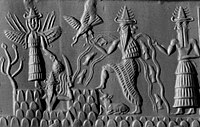Mušḫuššu
Babylonian mythology | |
| Other name(s) | Sirrush |
|---|---|
| Region | Mesopotamia |
The mušḫuššu (𒈲𒍽; formerly also read as sirrušu or sirrush) or mushkhushshu (pronounced
The form mušḫuššu is the Akkadian nominative of Sumerian: 𒈲𒍽 MUŠ.ḪUŠ, 'reddish snake', sometimes also translated as 'fierce snake'.[2] One author,[3] possibly following others, translates it as 'splendour serpent' (𒈲 MUŠ is the Sumerian term for 'serpent'). The older reading sir-ruššu is due to a mistransliteration of the cuneiform in early Assyriology[4] and was often used as a placeholder before the actual reading was discovered.[5]
History
Mušḫuššu already appears in Sumerian religion and art, as in the "
The mušḫuššu was the
The
-
9th century BCE depiction of the Statue of Marduk, with his servant dragon Mušḫuššu at his feet. This was Marduk's main cult image in Babylon.
-
Head of dragon dating from theLouvre Museum's collection
See also
References
- ^ ISBN 978-90-72371-52-2.
- ^ "The Electronic Text Corpus of Sumerian Literature". The ETCSL project, Faculty of Oriental Studies, University of Oxford. 2006-12-19. Retrieved 2014-08-25.
- ISBN 9780698106130– via Internet Archive.
- ISBN 0-918986-16-8.
- ^ Ceram, C. W. (1967). Gods, Graves, and Scholars: The Story of Archaeology. Translated by Garside, E. B.; Wilkins, Sophie (2nd ed.). New York: Alfred A. Knopf. p. 294.
- ISBN 978-90-72371-52-2.
- ISBN 978-90-72371-52-2.
- ISBN 978-0-8122-3557-9.
- ISBN 978-90-56-93005-9.
- ^ E. Weidner, Gestirn-Darstellungen auf Babylonischen Tontafeln (1967) Plates IX–X.
Notes
- 1.^ Similar to the Set animal in Egyptian mythology and the Qilin in Chinese mythology.




